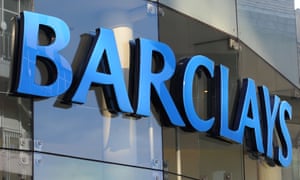Bank’s new broom Jes Staley likely to face shareholder questions about cut to dividend amid losses on oil-related loans

Barclays reported first-quarter profits of £793m and a 15% rise in bad debts. Photograph: Joe Giddens/PA
Barclays has revealed it has received approaches for its African operations – which its former chief executive Bob Diamond wants to buy – as it reported a 25% slump in first-quarter profits and losses on oil-related loans.
The bank, currently undergoing a restructuring under its new chief executive, Jes Staley, reported first-quarter profits of £793m and a 15% rise in bad debts, largely a result of problems facing clients in the oil and gas sector.
Staley, an American banker who took the helm in December after a hiatus in the boardroom, also warned Barclays’ investment bankers that their bonuses would be cut because of a slowdown in the industry.
Staley said there had been expressions of interest in the African business, which was put on the market last month. Jes Staley.
“On Africa, we continue to explore opportunities to reduce our shareholding to a level that achieves regulatory deconsolidation, including capital market and strategic options, and we are pleased with the level of indicative interest in what is a high quality business,” said Staley.
He did not name the potential buyers for Barclays Africa, a complex business that is listed on the Johannesburg stock market and in which Barclays has a 62.5% stake. However, Diamond, who was chief executive of Barclays before being forced after the Libor rigging scandal, said on Tuesday that he had the funding to table a potential offer.
Staley does not necessarily want to sell the entire stake in Barclays Africa, but lower it to below 20% as part of a plan to preserve capital, which has already led him to cut the dividend for this year and next.
He has said it could take up to two years to dispose of the African stake but the possibility of a faster than expected disposal sparked questions from analysts about whether the dividend cut could be rethought.
A year ago the bank’s profits were knocked by £1bn of charges in anticipation of fines for rigging foreign exchange markets and more payouts for payment protection insurance. This quarter the charge for such misconduct was £78m.
Staley has created two major divisions at Barclays, a UK arm and a corporate and international division, in anticipation of the ringfencing rules that come into force in 2019 and require separation of risky investment banking operations from UK high street customers.

Bob Diamond's interest in Barclays Africa confirmed
Read more
The bank had already warned that trading in its investment banking arm – once the powerhouse of the business – was slowing and profits in this division were down 31%, although this was not as bad as feared by the market.
Staley said that though the investment banking arm had performed well compared with its US peers he was keeping a close watch on costs. “We will adjust bonuses for 2016 appropriately, given that our year over year revenues were down, and mindful of the fact that the industry more widely has made dramatic cuts to performance accruals in the first quarter,” he added.
Profits in the UK arm fell 2% amid fierce competition in the mortgage market.
There is also a non-core division that includes parts of the investment bank as well as its Egypt and Zimbabwe banks and its continental retail bank. On Wednesday, it announced talks to sell its 74-branch network in France to AcaCap Financial Partners.bank’s chairman, John McFarlane, has previously expressed a preference for the UK to remain part of the EU and, as it published its first-quarter figures, the bank warned that it was “cautious as we approach the 23 June EU referendum”.
McFarlane will chair the bank’s annual general meeting on Thursday, where he will face questions about the cut to the dividend despite his pledge to bolster payouts to shareholders.
“The dividend cut is painful,” said Staley, who said major institutional investors were supportive of the decision while the non-core divisions was being sold off. Everyone wants the restructuring of Barclay to come to an end in a reasonable period of time,” said Staley.
“The performance of the core [part of the bank] today shows the potential power of the group once it is freed from the drag of non-core.”
Barclays has revealed it has received approaches for its African operations – which its former chief executive Bob Diamond wants to buy – as it reported a 25% slump in first-quarter profits and losses on oil-related loans.
The bank, currently undergoing a restructuring under its new chief executive, Jes Staley, reported first-quarter profits of £793m and a 15% rise in bad debts, largely a result of problems facing clients in the oil and gas sector.
Staley, an American banker who took the helm in December after a hiatus in the boardroom, also warned Barclays’ investment bankers that their bonuses would be cut because of a slowdown in the industry.
Staley said there had been expressions of interest in the African business, which was put on the market last month. Jes Staley.
“On Africa, we continue to explore opportunities to reduce our shareholding to a level that achieves regulatory deconsolidation, including capital market and strategic options, and we are pleased with the level of indicative interest in what is a high quality business,” said Staley.
He did not name the potential buyers for Barclays Africa, a complex business that is listed on the Johannesburg stock market and in which Barclays has a 62.5% stake. However, Diamond, who was chief executive of Barclays before being forced after the Libor rigging scandal, said on Tuesday that he had the funding to table a potential offer.
Staley does not necessarily want to sell the entire stake in Barclays Africa, but lower it to below 20% as part of a plan to preserve capital, which has already led him to cut the dividend for this year and next.
He has said it could take up to two years to dispose of the African stake but the possibility of a faster than expected disposal sparked questions from analysts about whether the dividend cut could be rethought.
A year ago the bank’s profits were knocked by £1bn of charges in anticipation of fines for rigging foreign exchange markets and more payouts for payment protection insurance. This quarter the charge for such misconduct was £78m.
Staley has created two major divisions at Barclays, a UK arm and a corporate and international division, in anticipation of the ringfencing rules that come into force in 2019 and require separation of risky investment banking operations from UK high street customers.

Bob Diamond's interest in Barclays Africa confirmed
Read more
The bank had already warned that trading in its investment banking arm – once the powerhouse of the business – was slowing and profits in this division were down 31%, although this was not as bad as feared by the market.
Staley said that though the investment banking arm had performed well compared with its US peers he was keeping a close watch on costs. “We will adjust bonuses for 2016 appropriately, given that our year over year revenues were down, and mindful of the fact that the industry more widely has made dramatic cuts to performance accruals in the first quarter,” he added.
Profits in the UK arm fell 2% amid fierce competition in the mortgage market.
There is also a non-core division that includes parts of the investment bank as well as its Egypt and Zimbabwe banks and its continental retail bank. On Wednesday, it announced talks to sell its 74-branch network in France to AcaCap Financial Partners.bank’s chairman, John McFarlane, has previously expressed a preference for the UK to remain part of the EU and, as it published its first-quarter figures, the bank warned that it was “cautious as we approach the 23 June EU referendum”.
McFarlane will chair the bank’s annual general meeting on Thursday, where he will face questions about the cut to the dividend despite his pledge to bolster payouts to shareholders.
“The dividend cut is painful,” said Staley, who said major institutional investors were supportive of the decision while the non-core divisions was being sold off. Everyone wants the restructuring of Barclay to come to an end in a reasonable period of time,” said Staley.
“The performance of the core [part of the bank] today shows the potential power of the group once it is freed from the drag of non-core.”









0 коммент.:
Post a Comment